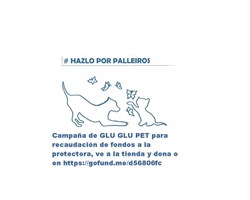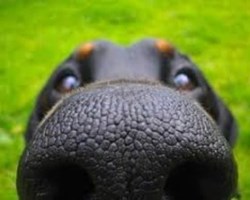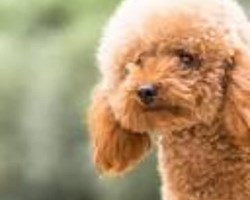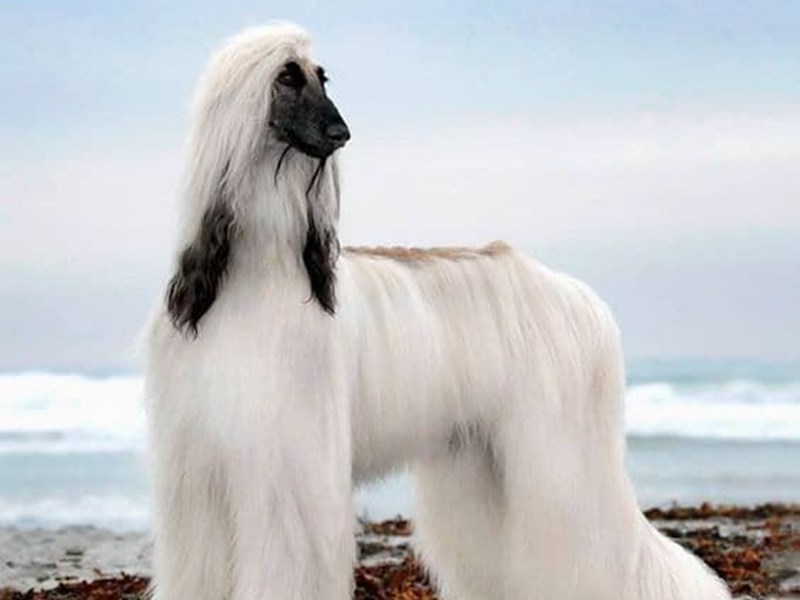
INDEX:
1.- ORIGIN.
2.- CHARACTERISTICS.
3.- BEHAVIOR AND PERSONALITY.
4.- NUTRITION.
5.- CARE
1.- ORIGIN:
The origin of the Afghan greyhound is ancient, with the first records around the year 1000 BC. C., in the area where Afghanistan is currently located.
It was used as a hunting dog.
This breed arrived in England in 1920 and was soon successful, being recognized by the British Kennel Club only six years later.
In the year 1880, when the war between the Afghans and the British ended, the officers of the British army took home some of these dogs, whose characteristics as hunting dogs in the harsh conditions of the Afghan mountains had attracted their attention.
In Europe, the Afghan greyhound has maintained its natural activity as a herding and hunting dog, a task that it already did in its homeland.
Also, thanks to its elegant appearance, agility and speed, it has become a companion and racing dog.
Initially, the Afghan hound was used to chase prey of all kinds, found in the mountains of Afghanistan, such as hares, foxes, gazelles, jackals, wolves, deer, and even leopards.
Another function of the Afghan hound was guarding the camps of the nomadic tribes and the cattle, functions that, together with those related to hunting, gave this breed enormous popularity among the nomads of Afghanistan, even reserving a dedicated day of festivity. to the Afghan hound, in which they were adorned with flower necklaces.
Attempts have been made to use the breed in Europe for greyhound racing, but have never been successful.
The problem is given by the fact that the Afghan hounds are too intelligent for this type of racing, and they do not chase the mechanical hare as any greyhound would, but plan a real hunting strategy to capture the hare: they cross center area of the race track and pounce on them as the stuffed animal spins toward the Afghan Hound.
Known in Spain as a greyhound, its origin is probably located in Afghanistan and it is suspected that it arrived there from what is now Iran. It is in the area of Asia where it has a more visible coat due to the climate with which it lives.
It is a dog that needs very special care due to its long and colorful hair.
The Greyhound is originally a hunting dog, due to its physical constitution and its morphology it can reach great speed, which is why in some cultures it is used to participate in races.
The Greyhound does not stand out for its visible sociability with humans, which can make us believe that it is not comfortable with us.
On the contrary, although it is a little affectionate and independent dog, it does like to live with humans and will not like to be alone.
A greyhound is not a lap dog, although it is faithful and noble.
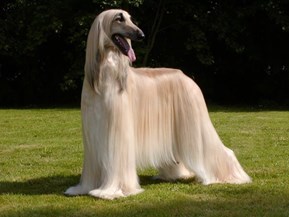
2.- CHARACTERISTICS:
For males, the height at the withers is between 68 and 74 centimeters.
For females, the height at the withers is between 63 and 69 centimeters.
The International Cynological Federation standard does not specify a weight for this breed, but Afghans typically weigh between 26 and 34 kilograms.
Its main physical characteristic is long hair, in addition to its long head and tail ending in a ring.
The coat is long and very fine over much of the body, forming a distinctive tuft from the forehead to the back of the head.
It is short on the face and from the shoulders to the back of the back.
All colors are allowed for this breed of dog.
The Afghan Hound is a strong and light dog with a solid and noble appearance.
Tall and elegant, noble and brave, intelligent and loyal, the Afghan hound is a majestic dog.
There have even been those who have described it as “the king of dogs”.
The refined head of this sighthound is elongated, though not very thin, and is well proportioned to the body.
It houses almost triangular eyes with a majestic and distant expression.
On the sides of the head, and well back, are the ears covered with long, silky hair, which contribute to the elegant and noble appearance of this dog.
A long, strong neck supports the majestic bearing of the Afghan Hound's head.
The elongated snout of the Afghan hound has powerful jaws with scissor-like teeth.
Thanks to this powerful bite, the Afghan hound is one of the best hunting dogs in the world.
The strong and powerful body of the Afghan Hound features a straight back and moderate length.
The relatively short, straight loin continues with a slightly sloping croup.
The very prominent hip bones are well separated from each other.
The deep chest of this sighthound features moderately sprung ribs.
The Afghan Hound's tail is typical of the breed. It is low inserted and forms a distinctive ring at its end. It is also covered with hairs that give it the appearance of a thin feather.
In large dog breeds like this, an extra contribution is very important to reinforce the cartilage since they tend to wear out more than other breeds. Hyaloral is a product in comfortable chewable tablets that will help protect your body against possible injuries.
Size:
Weight range:
Males: 23 - 27 kg
Females: 23 - 27kg
Height at withers:
Males: 68cm
Females: 63 cm.
Dolichocephalic (long face), floppy ears (naturally).
Expectations:
Energy level: medium
Life expectancy: 12 - 14 years
Tendency to drool: low
Tendency to snore: low
Tendency to bark: low
Tendency to dig: low
Need for attention/Socialization: low
Bred for:
coursing and hunting
Hair:
length: long
Features: silky
Colors: any color except speckled
General grooming need: high
Club Recognition:
Royal Canine Society of Spain (RSCE): Greyhounds
United Kennel Club (UKC): Sighthounds and Pariahs.
The male is approximately 70 cm and the female can be slightly shorter and usually weigh between 23 and 27 kg.
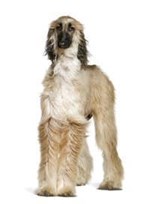
3.- BEHAVIOR AND PERSONALITY:
The Afghan hound has a majestic appearance due to its proud bearing and long, silky hair.
This breed has a characteristic profile:
- A strong, arched neck.
- Marked hips.
- Large limbs.
- Apparently exaggerated curve in the knees.
- Ring-shaped tail.
- The head and muzzle are elongated, narrow and refined, with a slightly convex curve to the muzzle.
- The ears are long and covered with even longer hair.
- The crown, forelegs, chest, flanks, hind legs and legs are densely covered with long, fine, silky hair.
- The hair on the face and back, or saddle, is short and shiny.
- The most common hair colors are black, black and brown, red, cream, blue, brindle, domino and white.
Afghan Hounds can also come in a wide variety of shades, with creams and reds often, but not always, having black masks.
Puppies do not resemble long-haired adults, having curly hairs on their cheeks, known as "monkey whiskers," and on their backs.
The short, bushy hair of puppies begins to fall out at about a year of age, giving way to shiny adult hair that lengthens at a constant rate.
In motion, it has a striking appearance thanks to its springy and powerful gaits.
The Afghan Hound is a very independent dog, a bit distrustful and distant.
It appreciates the company of its owners and does not tolerate loneliness well, it is loyal and affectionate, but it does not usually show open affection towards people.
The Afghan hound is not the best pet for families with young children, since due to its sensitive personality, it does not tolerate being disturbed well, and can lead to occasional aggressions, due to the anxiety and stress caused.
However, it can get along very well with older children, 10 years and older, who are considerate of pets.
All this independence makes the Afghan Hound a special breed and not an ordinary pet.
This does not mean that they are not good companions for the owner who is not thinking of presenting them in beauty pageants, it only means that they are not necessarily the type of dog that fits in all households.
To appreciate these dogs it is essential to understand them.
It is necessary to think like an Afghan Hound to be able to see the world as they see it.
They are not lapdogs, they are friends with a strong commitment.
They also have a lot of strength and courage.
For a long time it was considered a dog that was not very obedient and difficult to train, but with the evolution of dog training methods it has been seen that the Afghan hound can be easily trained if it is treated in a good way.
The best methods to train this dog are positive training methods such as clicker training.
Although the Afghan Hound is highly intelligent, this intelligence does not show through learning tricks or any form of training.
Afghan Greyhounds are self-taught, which means that they do not usually copy the behavior of other dogs, but rather create their own.
True to his origins as a hunter, he has been bred to react quickly.
It is an independent dog with a strong character, as well as distant and self-confident.
In a compendium of contradictions, the Afghan Hound has been described as extremely brave but perhaps shy, nervous but sometimes quiet and lazy, solemn but comical.
The image of the Afghan hound ranges from affectionate to extremely aloof, and these dogs can be very suspicious of strangers.
If not properly socialized, the Afghan has a tendency to develop a wild character.
In terms of character, the Afghan Hound is sweet and affectionate, very calm and reserved, but shows all its nobility with attitudes that are sometimes a bit “proud”.
For example, it does not respond to commands and this could lead one to think that it is an unintelligent dog, quite the opposite: the Afghan hound is only very sophisticated, it simply decides to do what it wants and when it wants.
Even with other people he can seem conceited, because he generally considers them small, and shows a behavior that could almost remind that of a cat, a bit "snobbish".
In some cases, if a stranger tries to give you a slightly loud command, you might also respond with a growl. But with the owner, the Afghan hound develops a very close, true love relationship, and is always ready to do anything for him.
With regard to coexistence, you have to be very careful in his relationship with other pets, since he is not an "easy" dog, for example with cats, where his hunting instinct could predominate.
Instead with his human friend, the Afghan hound will always be looking for long walks with him, it is a dog that has a very cheerful character, and has excellent qualities that must be stimulated and accompanied.
It is a dog that requires a lot of maintenance for different reasons.
Although highly intelligent, Afghans can be difficult to train due to their stubbornness.
They are extremely sensitive to harsh corrections, often resulting in a refusal to obey.
They respond best to gentle guidance and firm discipline.
Although they can be good floor dogs and can become flattened, they need plenty of exercise to fight off boredom and destructive behaviors like biting.
At a minimum, Afghans should walk a mile to two miles a day, and it's essential that they have a fenced-in yard for running.
This breed is famous for ignoring calls or pleas, and on the other hand it is a breed very prone to being run over, therefore, they should never wander unattended, as their predatory instinct can make them a threat to neighborhood pets.
With proper training and owner vigilance, Afghan Hounds can be compatible with both children and other pets.
Afghans are extremely thin under their thick coats, and they eat much less than their size would suggest.
Characteristic features that Glu Glu Pet tells you about this breed to take into account:
- Dog suitable for owners with some experience.
- Extra training is required.
- He likes active walks.
- He likes to walk more than two hours a day.
- Big dog.
- It requires daily grooming.
- Non-hypoallergenic breed.
- Expressive and barking dog.
- It is not a guard dog.
- May need training to live with other pets.
- May need training to live with children.
He is often aloof with strangers, so socialization is essential for this regal dog, as is puppy training, especially so that he learns to respond to the owner's call.
You will not show any reservations with your family and people you know.
He is extraordinarily loyal and affectionate.
The Afghan hound is made to run and his happiest moment is when he is running at full speed with the wind caressing his fur behind a ball or a squirrel he has discovered.
The character of the Afghan hound, as a good hound, is that of a "worthy" dog, brave, affectionate, energetic, very loyal and also sensitive.
It is a dog of a single person or at most of the nucleus of the family and they are usually distrustful dogs with strangers, do not look for an effusive reception from an Afghan in any case, although without becoming aggressive dogs.
Nor can it be considered a very barking dog, which makes it a dog not very suitable for guarding the house, although it is a quieter dog.
An Afghan hound needs a high degree of activity and play.
It is not the most suitable companion to live in small spaces, as it needs space to be able to run and snoop around freely.
Although calm indoors, the Afghan Hound should not be left unattended for long periods of time nor should he be deprived of any running exercise, as he is easily bored and can later become a seriously destructive fluff.
It is a very independent dog, which can make its education somewhat more difficult, although this does not prevent it from being educated efficiently to make the Afghan Hound a balanced dog and a good companion with a certain amount of patience.
A rough or brusque treatment of this dog is not advisable due to its sensitivity and spirit.
Rough treatment can make an Afghan Hound withdrawn, so gentle, gentle treatment with kindness and patience works much better on this type of breed.
The ideal owner of an Afghan Hound should be ready to spend a lot of time with their pet, either because their coat needs constant maintenance, or because as an aristocratic dog, the Afghan Hound does not tolerate being ignored or neglected. take into account; otherwise, he can develop particularly stubborn attitudes and start to feel like the leader of the pack.
If the owner knows how to spend time with his four-legged friend, he will reciprocate with a lot of love and affection (although, unfortunately, this does not always mean obedience…).
However, it is a sensitive breed and should be treated as such, with its needs met.
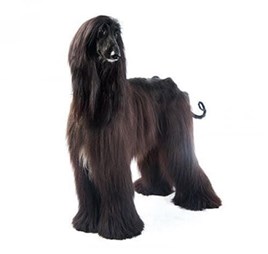
4.- NUTRITION:
Large breed dogs require a different balance of nutrients, including minerals and vitamins, than smaller dogs.
The Afghan Hound is prone to bloating and other stomach problems; smaller and more frequent meals could minimize the risk.
The Afghan Hound can be considered a large dog breed and therefore should be fed the recommended amounts of food for its size, age and also according to its daily physical activity.
If cookies or any other food that is good for him outside of his diet is given, the intake should be smaller in order to avoid being overweight or other problems related to the digestive system.
Dogs, believe it or not, also get bored of always eating the same thing, apart from the fact that their digestive system adapts to what they always eat, so a variety in the dog's diet from time to time is good.
Combine dry feed diet, which is preferred by the Afghan Hound, with wet or dehydrated food or feed, yes, always do it in different doses for each type of feed or food and with the recommended amounts of each type of food for dogs.
Since it has a very dense and silky coat, a source of essential oils given by a type of diet such as Omega3 can be a very convenient food, such as salmon food, it will be able to satisfy all the needs of the Afghan Hound, in addition to helping to maintain its shiny and silky fur as well as taking care of its joints and bones in perfect condition.
At Glu Glu Pet we recommend the following:
- ANC Fresh complete chicken.
- ANC fresh lamb.
- ANC fresh puppy.
- IMAGINE LAMB & RICE.
- IMAGINE LARGE ADULT 15KG.
- IMAGINE LARGE PUPPY.
- IMAGINE SENSITIVE.
- TRUE INSTINCT MEDIUM ADULT SALMON AND VEGETABLES 300g.
- Salmon oil Dr. Clauder´s 250ml.
- HEALTHY PET SALMON OIL 500ml.
- Advance appetite control snacks.
- Advance sensitive snacks.
- ANC fresh salmon snacks.
- Pressed bones different sizes.
5.- CARE:
The glamorous, long, silky coat comes at a price: it takes a lot of work to keep it in perfect condition.
We recommend brushing it daily to prevent tangles and knots, and it will need regular baths to keep it clean.
It is especially important to brush it well when it sheds its puppy coat to prevent the new hair from becoming entangled with the old, causing discomfort.
The Afghan hound is a dog that needs various regular care, given its long hair, its low tolerance for pain and its general morphology, so you will surely spend a lot of time with it and more if you are one of those who usually participate in exhibitions or competitions. to show your pet.
The Afghan hound's coat must be maintained at least 2 or 3 times a week.
The spectacular coat of an Afghan hound deserves to always be radiant.
Brushing is essential to keep your Afghan Hound's coat in perfect condition.
Get him used to brushing as a puppy, as this will make it less tedious over time.
Haircutting and various grooming involves a great deal of technique and may be best done by a dog groomer for a better appearance and better maintenance of the coat.
Coat care requires more time than for other breeds.
At Glu Glu Pet we recommend for his fur:
Afghan bath.
The Afghan hound needs to be bathed more regularly than other dogs and frequent brushing is a must.
Some experts recommend brushing the Afghan Hound's coat only when the dog is bathed because wet hair is less damaged by brushing.
This can be a problem, as the Afghan hound sheds on a regular basis.
If possible, a dog groomer should take care of this sighthound's coat.
The frequency of the baths is not so important if the dog is a pet, but it can be of great importance if the dog is a show dog.
In either case, the health of the dog must be taken into account before aesthetics.
Regular grooming is essential to maintain their hair, they need weekly baths and brushing to remove dead hair and avoid tangles and knots to which they are so prone.
Adult Afghans shed in spring and fall, as well as after illness; unspayed female dogs shed at every change of season.
The maintenance of the coat of the Afghan Hound is demanding, it needs three brushing sessions a week and a monthly bath.
Products recommended by Glu Glu Pet for bathing your Afghan Hound:
- Artero Moisturizing shampoo 250ml.
- Artero Spray Balsam 250ml.
- Artero conditioner Protein Vital 100.
- Artero Earth perfume 90 ml.
- MEN FOR SAN Mink Oil Shampoo.
- MEN FOR SAN Puppies Shampoo 300ml.
- MEN FOR SAN White Hair Shampoo 300ml.
- MEN FOR SAN Shampoo Brown Hair 300ml.
- MEN FOR SAN Shampoo Black Hair 300ml.
- BUBBLES Detangling Shampoo 250ml.
- BUBBLES Shampoo for Puppies.
- BUBBLES White Hair Shampoo.
- BUBBLES Black Hair Shampoo.
- BUBBLES frequent use shampoo.
- DERMOCANIS Long Straight Hair Shampoo 250ml.
- DERMOCANIS Frequent Use Shampoo 250ml.
- Petuxe puppies shampoo 200ml.
- Petuxe shampoo for long and straight hair.
- Shampoo for all types of breeds (basic) Petuxe.
Check your Afghan Hound's ears, eyes and ears.
All breeds with floppy ears tend to have problems with ear infections, so it's a good idea to check your furry's ears at least weekly to prevent ear disorders or infections.
With a cotton ball moistened with specific liquids for this hygiene that your veterinarian can provide or indicate, you can clean his ears and ears.
Products recommended by Glu Glu Pet for grooming your Afghan's ears, eyes and ears:
- Crafty Pretty Eyes.
- Cunning eye cleaner thimble.
- Artero Aurigel - Ear cleaner.
- Cunning ear cleaner thimble.
Dental care.
Brushing teeth in the Afghan hound is important at least 2 or 3 times a week to avoid gum problems and thus be able to remove tartar and mitigate bad mouth odor.
They can also help you complement said cleaning, being something pleasant and quality that will give your pets a good time, some dog biscuits to have cleaner teeth.
At Glu Glu Pet we recommend:
- Oral cleaning kit for dogs.
- Toothpaste for dogs.
- ADVANCE DENTAL CARE Sticks monthly box.
- PRO PLAN dental pro-bar.
- DENTASTIX monthly box 5-10kg.
Caring for your nails.
Another of the hygiene rituals for a dog is to cut its nails, more than anything else so that it does not feel very uncomfortable and for the good of your furniture and floor, if you have a parquet or wooden floor.
Once or twice a month is enough.
While the dog is being cleaned, you can observe if it has wounds, sores or other possible problems in the eyes, ears or tail.
This exploration is important to prevent potential problems or detect them for a quick treatment, under such a layer of hair problems can be hidden that are not seen with the naked eye.
If it spends most of the time on the plot, with space to run and play, it is much better, it is not a dog for small spaces or for being locked up at home for a long time.
That yes, have a high fence and make sure that the whole place where it is closed well, because the Afghan is an expert escapist dog, given its independence and surely some escape prepares you.
The education of the Afghan Hound, like that of any dog, is best done as a puppy.
The Afghan Hound can become somewhat stubborn at times and having such a sense of independence can make his education a bit complicated, so it is better to start as soon as possible so that he gets used to it and manage to mitigate that character in the future, when he become an adult and have a dog as balanced as possible.
At Glu Glu Pet we recommend:
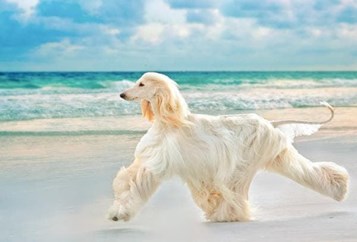
6.- HEALTH:
The Afghan Hound adapts well to living indoors as long as he is taken for a walk for at least an hour. It is also a dog that needs a lot of time for social life, otherwise it can become reserved and introverted.
Although the Afghan hound can live both inside and outside the house, it will feel much better if it is allowed to sleep inside, along with its own.
Despite this, the breed needs plenty of exercise and is not suited to apartment living.
A large, enclosed garden is necessary to allow the Afghan Hound to run as much as he needs.
The Afghan hound is normally a dog resistant to hereditary diseases.
Being a breed of very old hunting dogs, selection has played a very important role in reducing the genetic problems of this breed.
Despite this, there are some problems that can affect them:
- Malformation of the elbow joint.
- Hip dysplasia.
- Entropion.
It is very sensitive to chemical preparations:
- External antiparasitic.
- to anesthesia.
- to tranquilizers.
- to cortisone.
Afghans are generally quite healthy dogs, but each breed is prone to different diseases and may have certain health conditions predisposed by breed, so if you have or want to have an Afghan it is good that you know.
If you intend to have an Afghan Hound as a companion, it is always better to go to a breeder with a certain reputation and who has different health certificates such as dysplasia, either hip, elbow, hypothyroidism or von Willebrand, eye health certifications or thrombopathy, to name a few examples.
There are certain diseases or disorders to watch out for in this breed:
- Allergies: They are usually very typical in Afghans with symptoms such as sneezing, lethargy, nasal and eye secretions and hair loss. If any of these symptoms are observed in the Afghan Hound, do not hesitate to go to the vet for an examination and subsequent treatment.
- Canine cancer: Special attention to those sores or bruises that do not heal.
- Early Cataracts: One of the most common eye diseases in any breed of dog that an Afghan Hound is predisposed to have at an early age.
- Hypothyroidism: This disorder of the thyroid glands usually has symptoms ranging from;
- Ear infections.
- Bacterial skin infections.
- Fur loss.
- Depression.
- Lethargy.
The veterinarian, after analyzing and diagnosing the problem, will give the guidelines for a food diet, surely limited or restrictive of carbohydrates as a natural dog food and medication.
The Afghan Hound can be considered a large dog breed and therefore should be fed the recommended amounts of food for its size, age and also according to its daily physical activity.
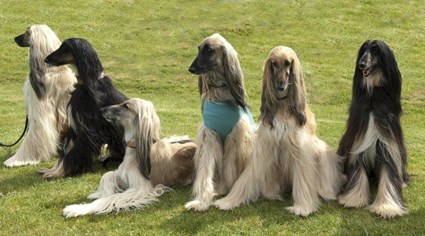
Given that it has a very dense and silky coat, a source of essential oils given by a type of quality homemade natural food and without artificial ingredients, such as Omega3, can be a very convenient food, such as dehydrated salmon food, it will be able to satisfy all needs of the Afghan Hound, in addition to helping to keep its coat shiny and silky as well as taking care of its joints and bones in perfect condition. The best for a born runner like the Afghan!
Purebreds live an average of 12 years, which is the standard for large breed dogs. It is a healthy breed, but it shares with the other greyhounds a particular sensitivity to anesthesia (due to a very low percentage of body fat) and, above all, a certain predisposition to allergies.
Their long, fur-filled ears can often end in their mouths and it is for this reason that it is not uncommon to see owners covering their dogs' heads with a hood to avoid this inconvenience.
Among other diseases that can affect an Afghan hound more often than other dogs is chylothorax, or the presence of lymphatic fluid in the pleural cavity.

